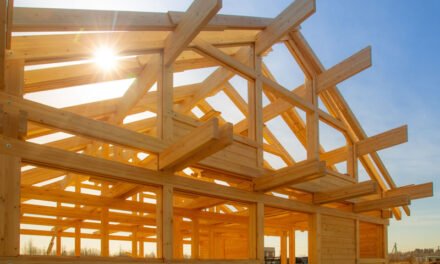Technologies combine to deliver whole-of-life building data in engineered timber construction.
It’s a familiar mantra from building designers and frame manufacturers: information is the key to success. Whether regarding site conditions, timber used, finishes or any of the dozens of intervening steps, the more you know about where you are building and what you are building with, the greater chance of a successful final product.
With that in mind, Hyne Timber‘s proposal for the Queensland Fire and Emergency Services (QFES) Complex in Maryborough, Queensland included being the first Glue Laminated Timber (GLT) manufacturer in Australia to provide Building Information Modelling (BIM) content for GLT in the project.
The proposal was welcomed by the Queensland Government after considering the design under the state’s market-led proposal framework, and is currently at the detailed design stage in collaboration with the client, with hopes for a 2019 start date. It forms the basis of the ‘Engineered Timber Fire Station: A Collaborative Journey of Innovation’ presentation in the Technology session at the Frame 2018 conference (see below for details).
Hyne Timber has led the Maryborough project in partnership with the University of Queensland (UQ) Centre for Future Timber Structures, Hutchinson Builders, X-Lam and Baber Studio. Katie Fowden, Hyne Timber’s manager strategic relations, said scanning, 3D modelling and topology optimisation were elements of the technology that will be used by the collective design team.
The BIM content for GLT will be in accordance with recently developed AS/NZS BIM standards [AS ISO 16739:2017, Industry Foundation Classes (IFC)].
But Hyne’s innovation isn’t just for one project team. Users of Autodesk Revit software, a leading BIM tool, can now access the Hyne Timber ‘GLT Families’ for designs incorporating Australian-graded, independently certified products for their timber projects while ensuring product specifications are accurate and reliable.
Rob Mansell, Hyne Timber’s GLT business development manager, described this as an important milestone for the design and construction industry. “Technology is transforming the way buildings are designed and BIM provides insight and tools to more efficiently plan, design, construct and manage buildings,” he said.
“As momentum grows towards the mandatory adoption of BIM, ensuring our product range provides BIM content is timely.”
THE BENEFITS OF BIM
BIM is much more than a buzz acronym in the industry. It’s closer to a new philosophy of building. Instead of looking at the various parts of a building’s life – planning, design, building, living, remodelling, demolition, recycling, etc – as discrete elements, they all combine to form a whole-of-life data set that is stored and accessible for all users. Each user is able to make decisions based on accurate information supplied by the others, and data should be easily supplied to external bodies, such as councils, thanks to the Standard’s emphasis on open-source IFC (Industry Foundation Classes) files, which can be freely exported and imported to proprietary software.
BIM allows for costs to be reduced throughout the lifespan of the project, but most particularly in construction. Because all the teams involved are talking to each other before the construction process begins, there is less room for confusion or misinterpretation. The 3D models that are a key part of BIM allow for design adaptations to be quickly understood by all build partners and can be used as both a planning tool with clients and a checking tool for contractors, saving on rectifications and late changes. If changes do occur, all partners know about them and their implications.
Timelines are shortened, transitions between building phases are made smoother and opportunities for collaboration and economies are easily spotted using BIM. All with documentation that is accurate and extensive. Future renovations or adaptations are also made easier and cheaper, and new technologies can be more readily integrated.
Hyne’s proposal for the QFES Complex had at its heart the provision of BIM content for the locally grown and engineered timber used in the design and build. The proposal is progressing through ‘Stage 2’, but the company’s BIM content is available to download now and is already being used by the design team.
Principal architect Kim Baber called it an example of the benefits of early contractor involvement. “For commercial projects, it isn’t simply a case of placing an order of GLT products. We need timber experts on the design team from the start,” he said.
“Working closely from the concept stage means we now have BIM content for the GLT components, something that didn’t previously exist.”
Baber said all product details, from dimensions, mass and volume, down to the colour and texture of GLT, could be brought into the 3D model in a single integrated BIM element. “This means we can exchange quantitative information with our consultant team, particularly the structural engineer, as well as clients, all from the same model,” he said.
Baber added, “Commercial projects require service and innovative solutions, and that is exactly what Hyne Timber has provided, enabling improved accuracy when sharing technical building information and saving considerable time.”
DATA GATHERED AND SHARED
More than just the details of the design’s GLT, Hyne’s contribution to the QFES Complex BIM began with a UQ collaboration. Post-graduate members of the Centre for Future Timber Structures scanned the existing Maryborough Fire Station building and surrounds. A rotating, hand-held laser scanner gathered 40,000 range measurements per second, which were converted into a 3D field of view.
The result was a precise model that could be used to document and plan interfaces between old and new structures.
Baber says that this level of precision is necessary for projects working with engineered timbers: “Entire timber structures are designed and prefabricated offsite to within a tolerance of 2mm.
“Such high levels of precision in both the scanning of the existing site conditions combined with contemporary prefabrication of both the Glue Laminated Timber (GLT) and Cross Laminated Timber (CLT) new building components will significantly increase the reliability and the efficiency of construction.”
Luke Churchin, Hutchinson Builders design manager, said GLT BIM content provides value beyond efficiencies during the design and construction stages.
“As a building company, it is important for us to provide the client with as much detail as possible in relation to the life cycle of the building,” he said.
“The benefits of BIM include the capacity to store data and detail relating to the project such as certification, chain of custody, inventory, warranties, energy consumption, equipment information and periodic maintenance procedures. This can simply be passed on to the end user for their facility management and ongoing building operation.”
The full story of the new QFES complex design will be told at Frame Australia’s ‘Timber Offsite Construction’ conference.
Frame 2018, ‘Timber Offsite Construction’, will be held on Monday and Tuesday 18-19 June at Park Hyatt, Melbourne. For details, visit www.frameaustralia.com












